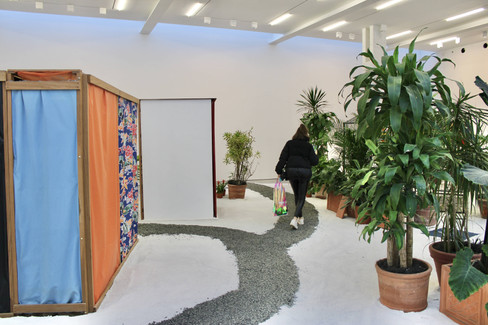Hélio Oiticica's 'Tropicália' at Lisson Gallery
- Aida Valdez
- Jan 17, 2021
- 2 min read
Updated: Jan 20, 2021
One of the leading figures of the avant-garde movement in Brazil, Hélio Oiticica, conceived the interactive installation Tropicália, currently on view at the Lisson Gallery in Chelsea. Tropicália was first exhibited in 1967 in Oiticica’s native city, Rio de Janeiro.

During the time of Tropicália’s original conception, Brazil was under a right-wing regime that overtook power through the coup d'etat in 1964. The government seeked to repress any activities, movements and ideas that, in their view, represented the left-wing’s way of thinking. Despite their censorship and incarcerations of artists and students, the right wing government was unable to repress the momentum and growth of the arts in Brazil that had flourished in the 50s and early 60s under Juscelino Kubitschek’s presidency. A cultural movement, encompassing music, theatre, film and visual arts was beginning to form in the late 60s and it took the name of Oiticia’s interactive installation, Tropicália.
Oiticica wanted visual art to be a space that would enable free expression. He began to explore past the conventional canvass and moved into three-dimensional spaces. Tropicália was conceived with participation and interaction from its visitors in mind. The installation consists of plants, sand, gravel, wooden sheds resembling housing in favelas, and even exotic birds. The combination of these creates an ambiance that brings to mind the stereotypical view of Brazil as a “tropical paradise”. He created a safe environment for interaction and participation that resembled Brazil - at the same time, it was a contradiction, given the political climate and the lack of free expression in the country.
Today, Oiticica’s work remains avant-garde and unusual in a gallery context. Entering the Lisson Gallery, in the heart of New York City, we found ourselves in a tropical environment with Macaw parrots, beautiful green plants and sand, all in the middle of white walls and bright modern lights. We were in awe. We carefully and quietly looked around, making sure not to touch anything. After being there for about 15 minutes without daring to walk on the sand (although it was not marked as off limits or ‘do not touch’), we were told that visitors were encouraged to walk on the gravel paths. Entering Tropicália changed our visit from a second-person perspective to an interactive and immersive experience, we were not just viewing, we were part of it.
We highly recommend this show - catch it on its last week at the Lisson Gallery through January 23, 2021.
Watch our Instagram Reel here for a more interactive experience of the installation. We used the eponymous song Tropicália, written by Caetano Veloso which addresses the same issues Oiticica and his contemporaries explored in their works.











Comments